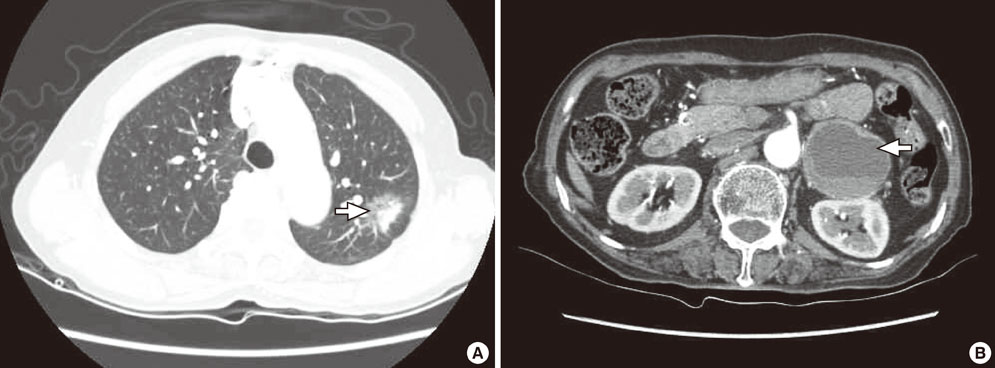Endocrinol Metab.
2011 Jun;26(2):155-159. 10.3803/EnM.2011.26.2.155.
A Case of Pheochromocytoma Presenting as Syncope Due to Orthostatic Hypotension
- Affiliations
-
- 1Department of Internal Medicine, Catholic University of Daegu School of Medicine, Daegu, Korea. jed15@cu.ac.kr
- 2Department of Pathology, Catholic University of Daegu School of Medicine, Daegu, Korea.
- KMID: 1497723
- DOI: http://doi.org/10.3803/EnM.2011.26.2.155
Abstract
- Patients with pheochromocytoma manifest with headache, perspiration, and palpitation. Although most patients have either sustained or paroxysmal hypertension, some patients present with hypotension. However, severe orthostatic hypotension is relatively rare in patients with pheochromocytoma. We report here on a 72-year-old woman with pheochromocytoma and she presented with recurrent syncope due to hypotension and blood pressure fluctuation. Syncope due to hypotension is unusual in patients with pheochromocytoma and only a few such cases have been reported. The present case serves to illustrate an unexpected presentation of this tumor.
Keyword
MeSH Terms
Figure
Reference
-
1. Ilias I, Pacak K. Current approaches and recommended algorithm for the diagnostic localization of pheochromocytoma. J Clin Endocrinol Metab. 2004. 89:479–491.2. Pacak K, Linehan WM, Eisenhofer G, Walther MM, Goldstein DS. Recent advances in genetics, diagnosis, localization, and treatment of pheochromocytoma. Ann Intern Med. 2001. 134:315–329.3. Shaw TR, Rafferty P, Tait GW. Transient shock and myocardial impairment caused by phaeochromocytoma crisis. Br Heart J. 1987. 57:194–198.4. Kobal SL, Paran E, Jamali A, Mizrahi S, Siegel RJ, Leor J. Pheochromocytoma: cyclic attacks of hypertension alternating with hypotension. Nat Clin Pract Cardiovasc Med. 2008. 5:53–57.5. Ueda T, Oka N, Matsumoto A, Miyazaki H, Ohmura H, Kikuchi T, Nakayama M, Kato S, Imaizumi T. Pheochromocytoma presenting as recurrent hypotension and syncope. Intern Med. 2005. 44:222–227.6. Guzik P, Wykretowicz A, Wesseling IK, Wysocki H. Adrenal pheochromocytoma associated with dramatic cyclic hemodynamic fluctuations. Int J Cardiol. 2005. 103:351–353.7. Baxter MA, Hunter P, Thompson GR, London DR. Phaeochromocytomas as a cause of hypotension. Clin Endocrinol (Oxf). 1992. 37:304–306.8. Streeten DH, Anderson GH Jr. Mechanisms of orthostatic hypotension and tachycardia in patients with pheochromocytoma. Am J Hypertens. 1996. 9:760–769.9. Song IA, Jung HJ, Cho DS, Yun JY. Unpredicted tachycardia and hypotension in a patient with medullary thyroid cancer and undiagnosed pheochromocytoma: A case report. Korean J Anesthesiol. 2009. 57:254–258.10. Bortnik M, Occhetta E, Marino P. Orthostatic hypotension as an unusual clinical manifestation of pheochromocytoma: a case report. J Cardiovasc Med (Hagerstown). 2008. 9:839–841.11. Shin DH, Kim SG, Kim DR, Kim NH, Choi KM, Baik SY, Choi DS, Suh SO. Clinical study of the pheochromocytoma. J Korean Soc Endocrinol. 2002. 17:554–563.12. Ramsay ID, Langlands JH. Phaeochromocytoma with hypotension and polycythaemia. Lancet. 1962. 2:126–128.13. Page LB, Raker JW, Berberich FR. Pheochromocytoma with predominant epinephrine secretion. Am J Med. 1969. 47:648–652.14. de Leeuw PW, Waltman FL, Birkenhager WH. Noncardiogenic pulmonary edema as the sole manifestation of pheochromocytoma. Hypertension. 1986. 8:810–812.15. Lever AF, Mowbray JF, Peart WS. Blood flow and blood pressure after noradrenaline infusions. Clin Sci. 1961. 21:69–74.



